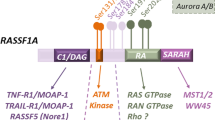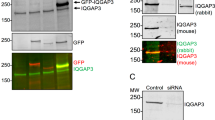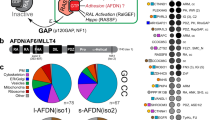Abstract
Ras proteins control the signalling pathways that are responsible for normal growth and malignant transformation1. Raf protein kinases are direct Ras effector proteins that initiate the mitogen-activated protein kinase (MAPK) cascade2, which mediates diverse biological functions such as cell growth, survival and differentiation3. Here we show that prohibitin, a ubiquitously expressed and evolutionarily conserved protein4 is indispensable for the activation of the Raf–MEK–ERK pathway by Ras. The membrane targeting and activation of C-Raf by Ras needs prohibitin in vivo. In addition, direct interaction with prohibitin is required for C-Raf activation. C-Raf kinase fails to interact with the active Ras induced by epidermal growth factor in the absence of prohibitin. Moreover, in prohibitin-deficient cells the adhesion complex proteins cadherin and β-catenin relocalize to the plasma membrane and thereby stabilize adherens junctions. Our data show an unexpected role of prohibitin in the activation of the Ras–Raf signalling pathway and in modulating epithelial cell adhesion and migration.
This is a preview of subscription content, access via your institution
Access options
Subscribe to this journal
Receive 12 print issues and online access
$209.00 per year
only $17.42 per issue
Buy this article
- Purchase on Springer Link
- Instant access to full article PDF
Prices may be subject to local taxes which are calculated during checkout





Similar content being viewed by others
References
Downward, J. Targeting RAS signalling pathways in cancer therapy. Nature Rev. Cancer 3, 11–22 (2003).
Kyriakis, J. M. et al. Raf-1 activates MAP kinase-kinase. Nature 358, 417–421 (1992).
Wellbrock, C., Karasarides, M. & Marais, R. The RAF proteins take centre stage. Nature Rev. Mol. Cell Biol. 5, 875–885 (2004).
McClung, J. K., Jupe, E. R., Liu, X. T. & Dell'Orco, R. T. Prohibitin: potential role in senescence, development, and tumor suppression. Exp. Gerontol. 30, 99–124 (1995).
Machuy, N. et al. A global approach combining proteome analysis and phenotypic screening with RNA interference yields novel apoptosis regulators. Mol. Cell Proteomics 4, 44–55 (2004).
Harari, D. & Yarden, Y. Molecular mechanisms underlying ErbB2/HER2 action in breast cancer. Oncogene 19, 6102–6114 (2000).
Gschwind, A., Fischer, O. M. & Ullrich, A. The discovery of receptor tyrosine kinases: targets for cancer therapy. Nature Rev. Cancer 4, 361–370 (2004).
Spencer, K. S., Graus-Porta, D., Leng, J., Hynes, N. E. & Klemke, R. L. ErbB2 is necessary for induction of carcinoma cell invasion by ErbB family receptor tyrosine kinases. J. Cell Biol. 148, 385–397 (2000).
Klemke, R. L. et al. Regulation of cell motility by mitogen-activated protein kinase. J. Cell Biol. 137, 481–492 (1997).
Dhillon, A. S., Meikle, S., Yazici, Z., Eulitz, M. & Kolch, W. Regulation of Raf-1 activation and signalling by dephosphorylation. EMBO J. 21, 64–71 (2002).
Kolch, W. et al. Protein kinase Cα activates RAF-1 by direct phosphorylation. Nature 364, 249–252 (1993).
Bruder, J. T., Heidecker, G. & Rapp, U. R. Serum-, TPA-, and Ras-induced expression from Ap-1/Ets-driven promoters requires Raf-1 kinase. Genes Dev. 6, 545–556 (1992).
Hekman, M. et al. Associations of B- and C-Raf with cholesterol, phosphatidylserine, and lipid second messengers: preferential binding of Raf to artificial lipid rafts. J. Biol. Chem. 277, 24090–24102 (2002).
Hekman, M. et al. Dynamic changes in C-Raf phosphorylation and 14–3-3 protein binding in response to growth factor stimulation: differential roles of 14–3-3 protein binding sites. J. Biol. Chem. 279, 14074–14086 (2004).
Mineo, C., James, G. L., Smart, E. J. & Anderson, R. G. Localization of epidermal growth factor-stimulated Ras/Raf-1 interaction to caveolae membrane. J. Biol. Chem. 271, 11930–11935 (1996).
Wang, S., Nath, N., Fusaro, G. & Chellappan, S. Rb and prohibitin target distinct regions of E2F1 for repression and respond to different upstream signals. Mol. Cell Biol. 19, 7447–7460 (1999).
Kolonin, M. G., Saha, P. K., Chan, L., Pasqualini, R. & Arap, W. Reversal of obesity by targeted ablation of adipose tissue. Nature Med. 10, 625–632 (2004).
Shields, J. M., Pruitt, K., McFall, A., Shaub, A. & Der, C. J. Understanding Ras: 'it ain't over 'til it's over'. Trends Cell Biol. 10, 147–154 (2000).
Kerkhoff, E. & Rapp, U. R. The Ras-Raf relationship: an unfinished puzzle. Adv. Enzyme Regul. 41, 261–267 (2001).
Avruch, J. et al. Ras activation of the Raf kinase: tyrosine kinase recruitment of the MAP kinase cascade. Recent Prog. Horm. Res. 56, 127–155 (2001).
Light, Y., Paterson, H. & Marais, R. 14–3-3 antagonizes Ras-mediated Raf-1 recruitment to the plasma membrane to maintain signaling fidelity. Mol. Cell Biol. 22, 4984–4996 (2002).
Dumaz, N. & Marais, R. Protein kinase A blocks Raf-1 activity by stimulating 14–3-3 binding and blocking Raf-1 interaction with Ras. J. Biol. Chem. 278, 29819–29823 (2003).
Kubicek, M. et al. Dephosphorylation of Ser-259 regulates Raf-1 membrane association. J. Biol. Chem. 277, 7913–7919 (2002).
Ory, S., Zhou, M., Conrads, T. P., Veenstra, T. D. & Morrison, D. K. Protein phosphatase 2A positively regulates Ras signaling by dephosphorylating KSR1 and Raf-1 on critical 14–3-3 binding sites. Curr. Biol. 13, 1356–1364 (2003).
Sharma, A. & Qadri, A. Vi polysaccharide of Salmonella typhi targets the prohibitin family of molecules in intestinal epithelial cells and suppresses early inflammatory responses. Proc. Natl Acad. Sci. USA 101, 17492–17497 (2004).
Hirohashi, S. & Kanai, Y. Cell adhesion system and human cancer morphogenesis. Cancer Sci. 94, 575–581 (2003).
Wang, K. J., Wang, R. T. & Zhang, J. Z. Identification of tumor markers using two-dimensional electrophoresis in gastric carcinoma. World J. Gastroenterol. 10, 2179–2183 (2004).
Srisomsap, C. et al. Detection of cathepsin B up-regulation in neoplastic thyroid tissues by proteomic analysis. Proteomics 2, 706–712 (2002).
Asamoto, M. & Cohen, S. M. Prohibitin gene is overexpressed but not mutated in rat bladder carcinomas and cell lines. Cancer Lett. 83, 201–207 (1994).
Smart, E. J., Ying, Y. S., Conrad, P. A. & Anderson, R. G. Caveolin moves from caveolae to the Golgi apparatus in response to cholesterol oxidation. J. Cell Biol. 127, 1185–1197 (1994).
Acknowledgements
We thank M. Oswald, D. Khalil, C. Dimmler, B. Fauler and U. Reichard for excellent technical assistance, T. Fowler for critical reading of the manuscript and the EURIT team for their help with siRNA validation. M. Selbach is thanked for kindly providing the Ras constructs and S. Lohmann for the VASP-P157 antibodies. This work was supported by grants from the Bundesministerium für Bildung und Forschung (BMBF) to T.R.
Author information
Authors and Affiliations
Corresponding author
Ethics declarations
Competing interests
A patent application has been filed.
Supplementary information
Supplementary Information
Supplementary figures S1, S2, S3 and S4; supplementary methods and movie legends (PDF 428 kb)
Rights and permissions
About this article
Cite this article
Rajalingam, K., Wunder, C., Brinkmann, V. et al. Prohibitin is required for Ras-induced Raf–MEK–ERK activation and epithelial cell migration. Nat Cell Biol 7, 837–843 (2005). https://doi.org/10.1038/ncb1283
Received:
Accepted:
Published:
Issue Date:
DOI: https://doi.org/10.1038/ncb1283
This article is cited by
-
Targeting PHB1 to inhibit castration-resistant prostate cancer progression in vitro and in vivo
Journal of Experimental & Clinical Cancer Research (2023)
-
New insights into the molecular mechanisms of ROR1, ROR2, and PTK7 signaling from the proteomics and pharmacological modulation of ROR1 interactome
Cellular and Molecular Life Sciences (2022)
-
STOML2 interacts with PHB through activating MAPK signaling pathway to promote colorectal Cancer proliferation
Journal of Experimental & Clinical Cancer Research (2021)
-
Prohibitin 1 is essential to preserve mitochondria and myelin integrity in Schwann cells
Nature Communications (2021)
-
Prohibitin regulates mTOR pathway via interaction with FKBP8
Frontiers of Medicine (2021)



